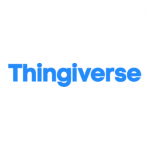In February of this year, a firestorm developed in the world of copyrights and 3D printing. A 3D model designer named Loubie, who had posted her design on Thingiverse, found that her digital blueprint (aka CAD file) was printed and sold on eBay by Just3Dprint. After voicing her concerns on the web, it turned out that Just3Dprint did the same thing with about 2,000 other designs. When Loubie complained, Just3Dprint responded by claiming that “[w]hen you uploaded your items onto Thingiverse for mass distribution, you lost all rights to them whatsoever. They entered what is known in the legal world as ‘public domain’.” MakerBot, the creator and manager of Thingiverse, responded by saying that “[w]hen Thingiverse users upload Things to Thingiverse, they choose the license under which they make their designs available, which can include [Creative Commons] licenses.”
Loubie quickly spread her story on the internet and supporters rallied to her call. Within weeks, either eBay or just3Dprint itself removed all of the objects 3D printed from Loubie’s digital blueprints. The controversy, while at least temporarily revolved, raises several important IP issues that 3D model designers should think about before uploading digital blueprints to the internet.
While Loubie’s digital blueprint and objects printed from it, which sparked the firestorm, may be copyrightable, this is not automatically true of all digital blueprints and the things printed from them. 3D printed objects are copyrightable only if they are artistic or creative in some way and are not purely functional. The same is true of digital blueprints, as long as they contain some human creativity and are not the result of a 3D scan that has not been modified in any way. In Loubie’s case, her design appears to have been her own creation of a dragon perched on a pedestal, and therefore the digital blueprint was probably copyrightable and objects printed from it are called “derivative works” under the copyright law. As a copyright owner, Loubie has the right to control the digital blueprint and derivative works printed from it. But if her digital blueprint was for a functional object like a kitchen gadget or a car door handle, the object would not be copyrightable; the design and digital blueprint, maybe. In any event, 3D printing objects from such designs would not be copyright infringement. Unless such an object was patented, it would have no IP protection and anyone would be free to copy and print it. It would be in the public domain.


How do you know if your design or object is copyrightable? The copyright law works in kind of a counterintuitive way. The only way to be sure is for a court to decide. But anything that CAN be copyrighted is automatically copyrighted the moment it is put into a tangible form. So how do you know if your design or object can be copyrighted? The easiest answer is to file an application to register it in the U.S. Copyright Office, which you can do yourself. If the Copyright Office accepts the application, your design or object is probably copyrightable, although a court could later disagree if you sue to enforce your rights. The US Copyright Office website provides all of the information you need to register a claim.
Assuming that a design is copyrightable, the designer should carefully read the terms of the licenses she agrees to when uploading it. Some file-sharing sites require anyone who uploads a design to agree to a Creative Commons license, which give others permission to use, share, and build upon their designs, or specify restrictions applicable to different types of users. CC licenses may have a non-commercial restriction, which says that users can’t sell the designs.
Depending on what license a file sharing website requires designers to agree to when they upload digital blueprints, they may or may not have any rights against a person who downloads the design, 3D prints it, and sells the objects. If the license gives the designer any such rights, she still may not have many options if someone violates those rights. Trial by public opinion may effective, which worked for Loubie. The offending objects disappeared from eBay and Thingiverse changed its user agreement.

File-sharing website user agreements may give users the right to download and print digital blueprints, but not to sell the designs or 3D printed objects. If a user sells the design or object, the designer can complain to the website that the user violated the license. Aside from using public opinion to shame the website into doing something about it, which worked for Loubie, designers may not always be this successful. The website agreement probably says that the website owner has no obligation to do anything if the user violates the agreement, except maybe to block the user’s future use of the website. This is normal too.
If the website user agreement allows the designer to enforce its copyrights, or if the user violates the rights that the designer granted to website users, legally enforcing these rights can be expensive and time-consuming. Even hiring an attorney just to threaten someone like Just3Dprint is usually costly enough to dissuade most designers from taking such a step to enforce their rights. For those who do choose this route, if the infringer does not capitulate, then the next step is to file a lawsuit, which is usually way too expensive for most designers. Although attorneys sometimes take such cases on contingency, meaning they only get paid if they win, designers are still often required to pay the costs of the litigation, which can be prohibitive, and attorneys only take such cases when the bad guy made enough money doing bad things with the design that both the client and the attorney can get a good return on investing in the case. There is a benefit to early copyright registration here: if the designer registers before suing, he is eligible (but not guaranteed) to recover attorneys’ fees if he wins.
All of this means that designers who make their digital blueprints available for download and 3D printing must either be willing to allow users to print and sell objects printed from the design or should be aware that their rights and their options for enforcing them may be rather narrow if someone prints and sells the design without permission.
The author wishes to thank Matthew Karas for his help in preparing this article.

Leave A Comment